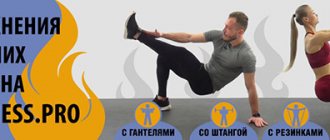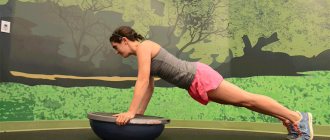Category: How to pump up Published 06/17/2017 · Comments: · Reading time: 5 min · Views: Post Views: 931
Fred Hatfield once shared the secrets of effectively using the “rest-pause” principle to grow muscle mass and strength. I will not list all his titles and knowledge, but most importantly, the scientific works that were written for bodybuilders, fitness instructors and powerlifting.
What does Fred pay special attention to? It is important not only to select the correct working weight, but also to literally maintain temporary rest pauses between approaches, since it is the observance of the time interval specified for each stage of training that allows you to achieve explosive growth in mass and strength.
However, get to the secrets of this bodybuilding principle sequentially, i.e. from simple to complex.
The principle of bodybuilding “rest-pause”
Even a novice bodybuilder knows (or at least should know) that muscle grows as a result of “progressive training.”
The muscle, trying to adjust and adapt to the loads that grow from training to training, begins to grow in volume in accordance with the physiological law - the diameter of the muscle is directly proportional to its strength capabilities. When working with heavy weights, you, accordingly, load the muscle more, and the muscle responds to the load by increasing its volume. Only this happens up to a certain stage. After about six months of training, the process begins to stall - the body adapts to progressive loads and the muscles practically stop responding to the training. More precisely, the observed growth does not correspond to the efforts made. The process is going so slowly that we can talk about stagnation.
This means that the time has come when the muscles need to be “surprised.” You know that the depth of muscle tension in bodybuilding, fitness, powerlifting and weightlifting depends on two factors:
- the total amount of work completed during the workout, i.e. total tonnage;
- exercise intensity or specific percentage of repetitions in an exercise.
You can try to “include” both factors in the training process to the maximum. However, experience shows that such attempts end in tearing of the heart muscle, exhaustion of the nervous system and a drop in immunity to “zero.”
It is for this reason that the fundamental technique of cyclic training has been introduced into the practice of athletic training (and into bodybuilding training), when first one and then another factor is used as the basis for organizing training.
For a bodybuilder who is interested in muscle volume, the “total tonnage” factor is more important. However, a simple progressive increase in working weights steadily, after 5-6 months, leads to stagnation. At one time, Joe Weider's students faced this problem. They came up with a solution that was subsequently not only tested, but also scientifically confirmed. This solution was called the “rest-pause” principle.
This principle of bodybuilding allows you to increase the training tonnage to incredible volumes, since in accordance with this principle, bodybuilding training occurs with maximum and submaximal weights.
On the other hand, a training scheme is proposed that is radically different from the basic one to which the body has already adapted.
Basic principles of high intensity training
Let's take a closer look at the principles of high-intensity training:
- Muscle shocking
. This program is quite monotonous. As a result of such training, it is possible to quickly get used to it and stop progress. In order to avoid this, you should ensure that the body does not have time to fully adapt to new weights. Stress is necessary to achieve muscle growth. Therefore, you should change not only the number of repetitions, but also the weight. The same goes for the angles at which the muscles work. Change the exercises, do not make the classes monotonous. This is the only way the muscles will not have time to adapt to the loads during training. - Work until failure
. This is one of the particularly important conditions that must be observed in order for muscle growth to occur quite impressively. Give your all during training, and then the processes of muscle growth will begin to take effect. - A priority
. First of all, it is necessary to work out weak muscle groups - when energy reserves are at their maximum level. - Cheating
. This is an excellent way to further increase the load. It is necessary to give the muscles more work. Therefore, this technique is used only as a supplement to the main exercises. If necessary, additional forces are activated to complete the exercise, cheating is performed by connecting other muscle groups to those already trained. - Super series principle
. This is performing two exercises in a row - they are worked by antagonist muscle groups. It turns out that you perform two approaches together through a short pause or without it. - Constant voltage principle
. Due to the fact that working at a high pace with weights is often not very effective, slow movements help create constant tension in the muscles. In addition, meaningfulness in actions and concentration are important. This will be an excellent impetus for further muscle development. - The principle of quality training
. Over time, breaks between approaches are reduced to a minimum. At the same time, the loads with each subsequent workout increase compared to earlier sessions. If you follow this rule, you will be able to obtain a venous appearance and improve the definition of muscle tissue.
Watch a video about high-intensity training: Everyone can achieve their goal - the main thing is to strive for it and not give up. If you build a training scheme correctly, it will be possible to increase your muscles and noticeably change in a positive direction and increase your strength.
Body-building. Rest-pause training
The classic form of organizing a workout based on the “rest-pause” principle looks like this:
- powerful warm-up;
- immediately after warming up, perform the exercise with a weight that allows you to perform 2-3 repetitions;
- rest 30-45 seconds;
- 2-3 more repetitions;
- rest 45-60 seconds;
- one more approach, but perform 1 repetition less than in the previous approach;
- rest 60-90 seconds;
- final 1-2 reps.
As a result, you perform 7-10 repetitions with a submaximal weight. The result is dramatic muscle growth!
The rest-pause principle can be combined with the pyramid principle, cheating, forced repetitions and negative repetitions. In short, here every bast goes in line.
Attention! Rest intervals must be strictly observed! Their duration is scientifically justified and is based on experimental data that was made on the analysis of the output of protein breakdown products from working muscles.
There is a more effective form of applying the “rest-pause” principle, but this technique can only be used by professionals in the later stages of increasing “mass” and only in certain cases to explode muscle mass:
- powerful warm-up;
- one repetition with maximum weight;
- rest 20-40 seconds;
- one repetition with a weight reduced from the maximum by 2% (no more);
- rest 2-40 seconds;
- in total, 8-10 single repetitions should be performed with rest pauses of no more than 30-90 seconds;
- if it is not possible to perform a repetition with the maximum weight, a reduction in the working weight is allowed, but no more than 4% of the maximum (selected for the first approach).
The principle is very effective and very dangerous! Especially for beginning bodybuilders, when both the heart muscle and the ligamentous system are not ready for intense training. The psyche is not yet ready to work on the borderline of “possible and impossible.”
For which exercises can the rest-pause principle be applied? For the basic ones. All basic ones, except squats.
The rest-pause principle cannot be applied in every workout - no more than once per weekly cycle for each muscle or muscle group. And not more often! And progress will be noticeable after 6-8 weeks of training.
For experienced athletes, Fred Hatfield has developed a super-effective training cycle:
- In the first workout, perform 5 sets of 5-8 repetitions with a weight of 80-90% of the maximum;
- On the second - 4 sets of 8-10 repetitions with a weight of 70-80% of the maximum;
- The third day is training based on the “rest-pause” principle;
- Day four – 4-5 sets of 10-15 repetitions with a weight of 60-70% of the maximum.
This system should be used to train for 8-12 weeks. It must be remembered that in one workout you cannot pump more than two muscles using the “rest-pause” method. Is it dangerous!
And when you return to “traditional” training, you will find that your results begin to increase. The reason for the growth is that your muscles have “forgot” about the previous training regimen and perceive it as new.
Essentially, bodybuilding training is repetition, but at a higher level each time.
I RECOMMEND:
- Muscle strength. advice from Georg Hackenschmidt * Training program to complete failure
- Training plan and periodization * The main secret of strength training
The need for high-intensity training
After prolonged exercise at high intensity, at some point growth slows or stops altogether. And there is no need to panic here. It is enough to understand exactly how the body adapts to high-intensity training. In addition, you should pay attention to the duration of rest. And then everything will work out - progress will resume.
If a bodybuilder trains regularly for two to three years, then his muscles get used to the high intensity of training, which means he needs to switch to a more powerful product, the level should now be even more impressive.
Intense training affects the rate of skeletal muscle growth. Thanks to efforts, stress occurs in the muscles, which forces the body to adapt to impressive loads. As a result, both muscle size and strength increase. But for constant progression, it is necessary to constantly increase the load from training to training. Thus, novice athletes increase the intensity of their training while performing basic, traditional training.
The thing is that doing exercises that do not create stress for the body will not lead to stimulation of progress. After all, muscle growth is nothing more than the body’s response to stress during overload. If the efforts generated are not intense enough for the body to defend itself and adapt, then growth stops.
If we talk about beginners, then any training provides a sufficient load for them. This means that adaptation will be excellent, muscle strength is growing quite quickly. To create an overload for the body, it is enough to switch from complete inactivity to training with moderate or even low intensity in this case.
By increasing the working weight, novice athletes manage to progress. The same goes for reducing rest time between sets. But when a beginner reaches a more advanced stage, the training regimen becomes more complicated, because there are already acquired physiological changes that are associated with muscle growth.
The more muscles, the more impressive the pressure on recovery abilities. The same applies to the body's reserves, which are used during intense muscle contractions. The average athlete is able to increase strength and intensity production capacity by approximately three hundred percent, but can only increase recovery capacity by fifty percent. It turns out that as you become stronger and bigger, the risk of overtraining increases.
Execution technique
Execution technique, for example, in the bench press. After performing 2-3 repetitions, the barbell is placed on the racks, then a rest of 30-45 seconds follows and another 2-3 repetitions are performed, then a rest of 45-60 seconds and a couple more such approaches are performed, then a rest of 60-90 seconds and the final ones are performed 1-3 reps. This works out to be one full set of 7-10 reps with submaximal weight. Such a sharp jump in load is unusual for the muscle, as is its new regime, which provokes the muscles to grow again after the gradual decline of the training athlete, which occurs after about six months of training.
Peculiarities
The depth of muscle growth depends on two factors[2]:
- the total amount of work performed during the workout, i.e. the total “tonnage” of all repetitions in all exercises;
- intensity of exercises or the specific percentage of repetitions in them performed with maximum weight.
Performing one-time repetitions, even with maximum weight, will not build muscles like Arnold Schwarzenegger or Honey. However, simply increasing the weight of the barbell or dumbbells only gives benefits for the first 4-6 months of bodybuilding training.
Experienced athletes also use a more intense form of the “rest-pause” principle in the later stages of their careers to further increase mass and, in some cases, as a remedy against “stagnation” - the “plateau” effect - in combination with other principles: “reverse pyramid”, “cheating”, “negatives”, etc.
Method #2 – Strengthening
1. 1-2 warm-up sets with a weight of 40% of the maximum weight - THIS IS MANDATORY!
2. Set the weight to 80-90% of your one-repetition maximum (this is the weight with which you can lift it cleanly without breaking technique just 1 time, if it’s a weight of 120 kg, then set the weight to around 100-110 kg);
3. Do 1 repetition with the calculated weight;
4. Rest for 40-45 seconds;
5. Perform as many repetitions as you can, no more than 8.
Reaching mega loads, muscle fibers are injured more, so rest increases , this is necessary so that blood flows to the places of ruptures and frees muscle areas from the process of protein breakdown, after which strength will increase slightly.
Variation
The following variants of the “rest-pause” method are distinguished[1]:
- classic
- the weight of the weight is selected such that it is possible to perform 3-5 repetitions and a “single” is performed, a pause of 10-15 seconds, then the next repetition of the “single”, and so on 6-8 times; - endless drop set
- the weight of the weight is selected such that it is possible to perform 3-1 repetitions and a “single” is performed, a pause of 10-15 seconds, then the weight is reduced by 5-10% and the next repetition of the “single”, and so on 6-8 once.











